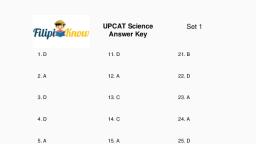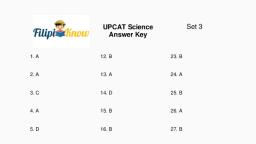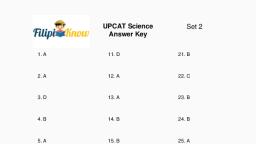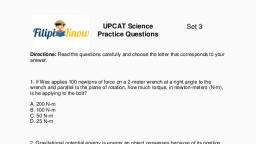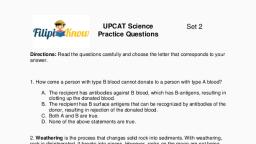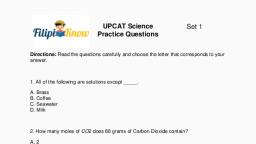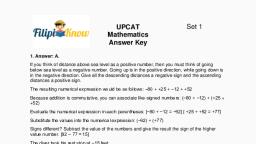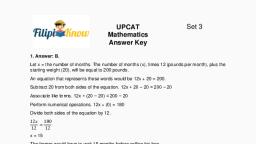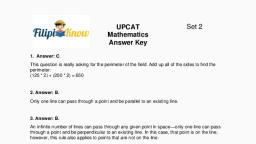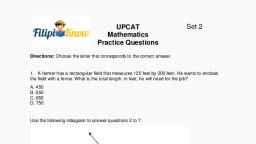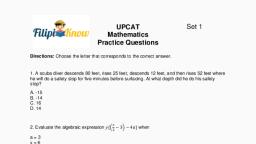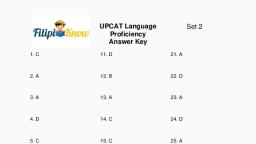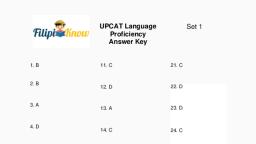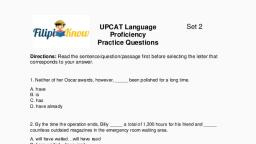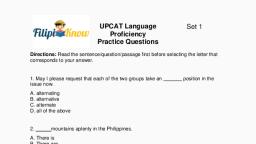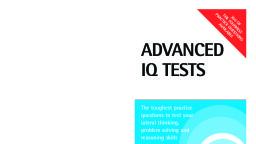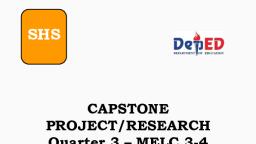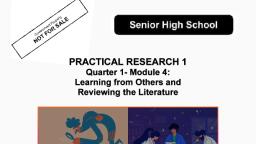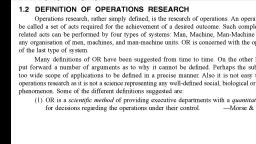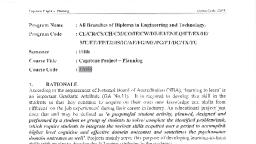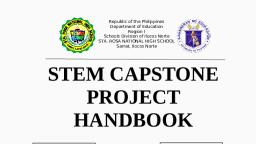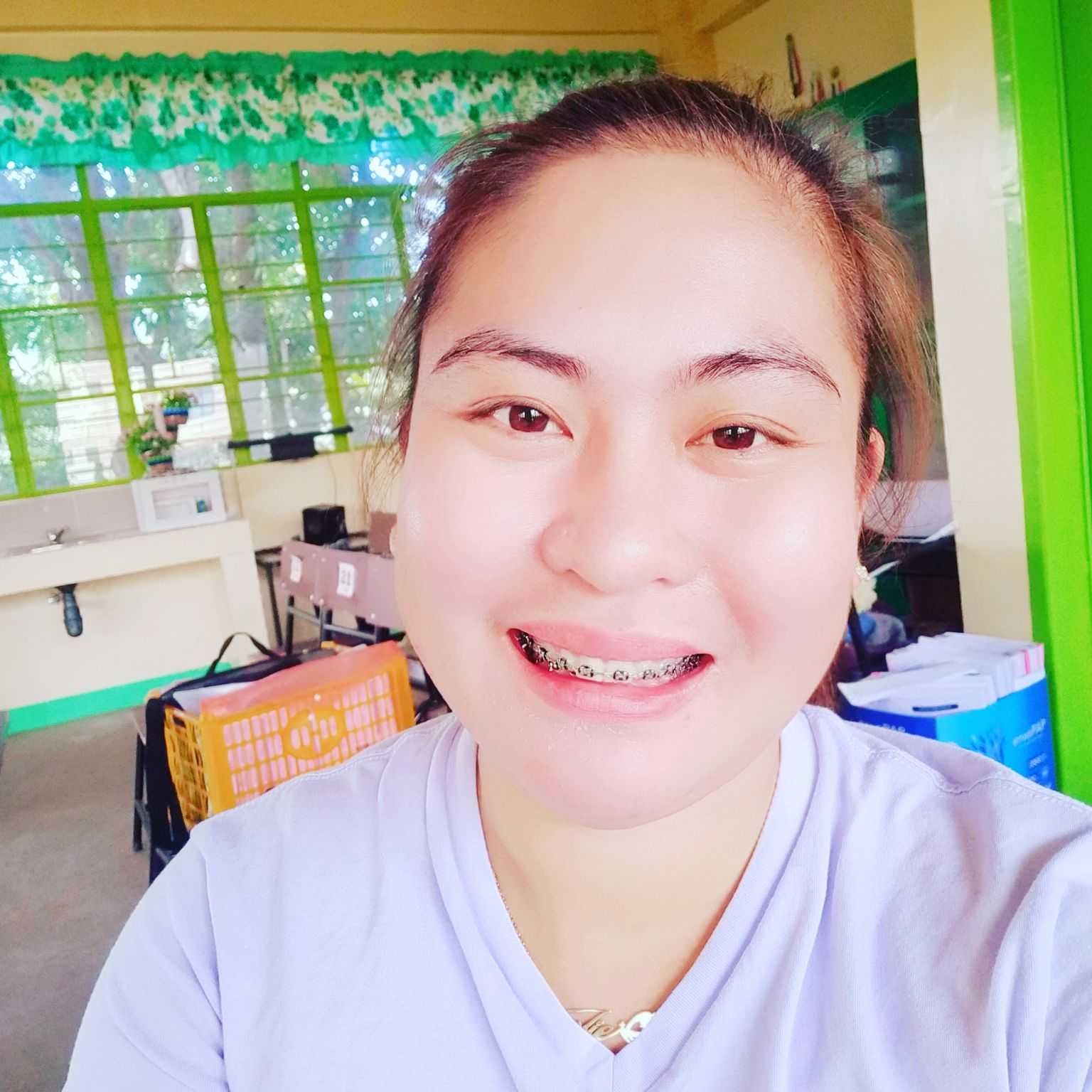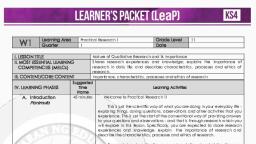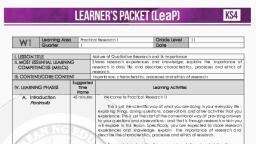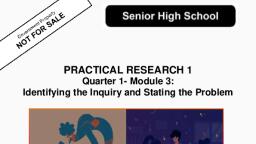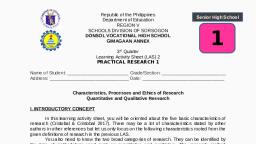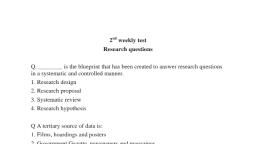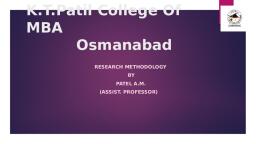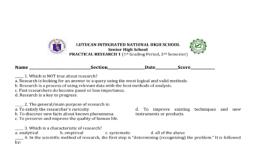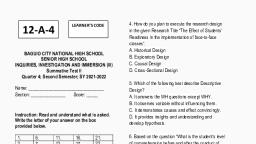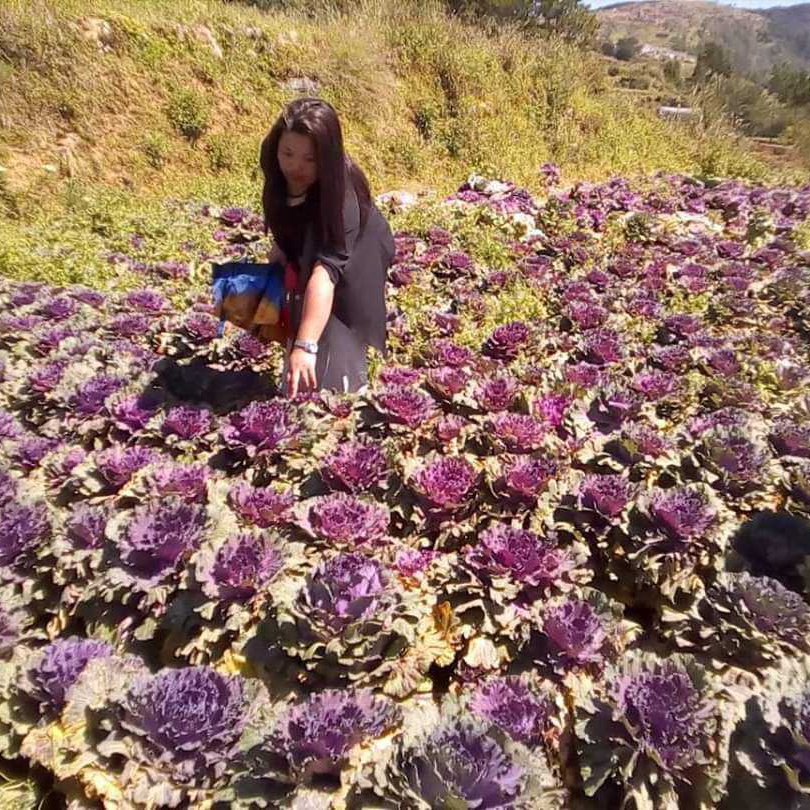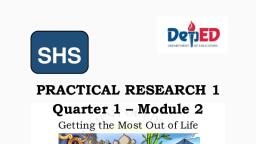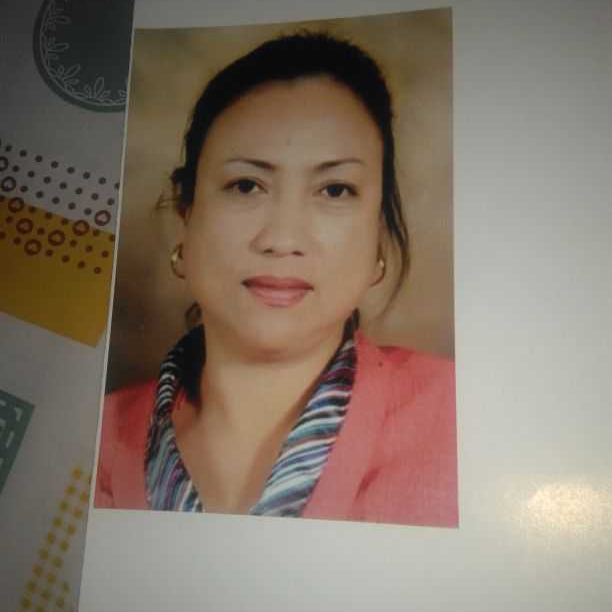Page 1 :
SHS, , CAPSTONE, PROJECT/RESEARCH, Quarter 3 – MELC 1-2, Week 1-2, The Scientific Problem, , REGION VI – WESTERN VISAYAS
Page 2 :
Capstone Project/Research, Activity Sheet No. 1 - The Scientific Problem, First Edition, 2021, Published in the Philippines, By the Department of Education, Region 6 – Western Visayas, Republic Act 8293, section 176 states that: No copyright shall subsist in any, work of the Government of the Philippines. However, prior approval of the government, agency or office wherein the work is created shall be necessary for exploitation of such, work for profit. Such agency or office may, among other things, impose as a condition, the payment of royalties., This Learning Activity Sheet is developed by DepEd Region 6 – Western, Visayas., ALL RIGHTS RESERVED. No part of this learning resource may be reproduced or, transmitted in any form or by any means electronic or mechanical without written, permission from the DepEd Regional Office 6 – Western V, Development Team of Physical Science Activity Sheet, Writer: RONILO V. APONTE, Division of Iloilo Management Team:, Dr. Roel F. Bermejo, Dr. Ferdinand S. Sy., Dr. Novelyn M. Vilchez, Dr. Azucena T. Falales, Ruben S. Libutaque, Lilibeth E. Larupay, Corazon C. Alarcon, Regional Management Team, Ramir B. Uytico, Pedro T. Escobarte, Jr., Elena P. Gonzaga, Donald T. Genine, Rovel R. Salcedo, Moonyeen C. Rivera, Anita S. Gubalane, Minda L. Soldevilla, Daisy L. Lopez, Joseph M. Pagalaran
Page 3 :
Introductory Message, Welcome to Capstone Research!, The Learning Activity Sheet is a product of the collaborative efforts of the, Schools Division of Iloilo and DepEd Regional Office VI - Western Visayas through the, Curriculum and Learning Management Division (CLMD). This is developed to guide, the learning facilitators (teachers, parents and responsible adults) in helping the, learners meet the standards set by the K to 12 Basic Education Curriculum., The Learning Activity Sheet is self-directed instructional materials aimed to, guide the learners in accomplishing activities at their own pace and time using the, contextualized resources in the community. This will also assist the learners in, acquiring the lifelong learning skills, knowledge and attitudes for productivity and, employment., , For learning facilitator:, The Capstone Research Activity Sheet will help you facilitate the leachinglearning activities specified in each Most Essential Learning Competency (MELC) with, minimal or no face-to-face encounter between you and learner. This will be made, available to the learners with the references/links to ease the independent learning., , For the learner:, The Capstone Research Activity Sheet is developed to help you continue learning, even if you are not in school. This learning material provides you with meaningful, and engaging activities for independent learning. Being an active learner, carefully, read and understand the instructions then perform the activities and answer the, assessments. This will be returned to your facilitator on the agreed schedule.
Page 4 :
Name of Learner:, , _, , Grade and Section:, , _, , Date:, , _, , CAPSTONE RESEARCH ACTIVITY SHEET NO. 1, The Scientific Problem, , I., , Learning Competency with Code, 1. Identify a scientific problem or question (STEM_RP12-Ia-e-1), 2. Differentiate applied and basic research problems (STEM_RP12-IIa-e-2), II. Background Information for Learners, In previous research related lessons, you have learned that research has a wide, coverage of application. In this course, you will utilize your Science and Mathematics, knowledge to provide solution to existing scientific problems or extends knowledge in the, chosen field of study., Capstone project is a culminating assignment similar to a college thesis which, involves a wider range of activities like critical thinking, deep analysis, and the ability to use, different media. Study under Capstone project may be classified into applied research or basic, research., Applied research creates practical solutions for specific problems while Basic, research seeks to expand knowledge in the field of study., Development of a Capstone Project, As a guideline, a capstone project will revolve around the following framework:, 1. Selecting a topic. It’s maybe a design, a solution to an existing problem or providing new, information about a certain topic, etc. Or this can be your subject of interest presented in, previous research subjects (Practical Research 1 and 2 or Inquiries, Investigations, and, Immersion., 2. Do a literature review. As background information to fill gaps that will give you a strong, foundation to work on and can spot any areas to improve upon., 3. Research your topic. Make sure your research is on target with your readings, feasible,, safe (constraints in the new normal), and practical., 4. Presenting your proposed study. Includes title proposal, scientific concepts the study is, anchored, variables, research questions, and sound methods., Learners’ skills needed in Capstone project development, 1. Critical thinking, problem-solving, oral communication skills, research skills, and teamwork., 2. Collaboration and the skills to connect with the community and analyze important issues,, problems, and ideas.
Page 5 :
III., , Activity Proper, , Directions: Working individually or in small group while facilitated by your teacher. Read and, follow the procedure carefully. Write the answers of the brainstorming activity in your research, logbook., , Activity 1: Leading or loading question?, Materials, •, , Readings-Literature review in the field of study and/or photos of the identified problem., , Given a sample concept map of a particular learner in the problem identification process,, answer the guide questions to come up with the proposed study., , Weak Immune System, , Vitamin C is an antioxidant, , Eat food rich in Antioxidant, , Method: Iodine Titration, , Determination of Vitamin C content, in locally grown vegetables, , Compute for Vitamin, C content &/or, Color intensity, , Figure 1.1. Concept map of a Science Investigation, Guide Questions:, 1. What is the problem or topic you have identified from the concept map?, _, , _, , _, , 2. What is the proposed solution to the problem or design or specimen to be investigated?, _, , _, , 3. What scientific concepts the proposed study is anchored?, _, , _, , _, , 4. What variables (Independent, Dependent and Controlled) are involved in the study?, _, , _, , _, , 5. Based from the given Independent Variable and Dependent Variable, what is the title of, the proposed study? (Ideally maximum of 12 words), _, , 6. What scientific questions can be formulated based from Independent and Dependent, Variables involved in the study?, _, , _, , _, , _, , _, , 7. Is the proposed study BASIC or APPLIED? Explain briefly., _
Page 6 :
8. What safety measures are to be considered in doing this study?, _, , _, , Activity 2, Directions: In doing this activity you need to follow the health and safety protocols in your, locality. If allowable and safe, conduct a visual scanning in your vicinity about an existing, problem. And do the following:, 1., If you have a topic already in mind, proceed to the initial review of literature to equip, you with the conceptual knowledge and updates about the topic of interest in terms of, procedure, recent findings, and application., 2. While doing the narrowing of your topic from complex to specific scientific problem/s,, along the way make a concept map (Figure 1.2), so that you can trace the development of, your problem identification., 3. Collaborate with your group mates or if alone, you can consult your research teacher., 4. Classify the proposed study whether it’s BASIC or APPLIED., , Figure 1.2. Concept mapping in the formulation of scientific problem from general to, specific, , 6. Write your main activities in your logbook., , _
Page 7 :
Guide Questions:, 1. What is the specific scientific problem or topic you have identified?, _, , _, , 2. What is your proposed solution to the problem or design or specimen to be investigated?, _, , _, , 3. What scientific concepts your proposed study is anchored?, _, , _, , 4. What variables (Independent, Dependent and Controlled) are involved in your study?, _, , _, , 5. Based from the given Independent Variable and Dependent Variable, what is the title of, your proposed study? (Ideally maximum of 12 words), , _, , _, , 6. What scientific questions can be formulated based from Independent and Dependent, Variables involved in the study?, _, , _, , 7. Is the proposed study BASIC or APPLIED? Explain briefly., _, , _, , 8. Why proposed this scientific study? Did you consider several ethical and safety, considerations?, (For guidance, aligned your answer on the development of a capstone project), , IV. Reflection:, Do you think that the problem you presented has the characteristics of a good, research problem? Why?
Page 8 :
OPTIONAL: VIRTUAL PRESENTATION OF PROJECT TITLE (For learners under online, class). Rubric for rating the oral defense, To a Very Great Extent, ( 17-20), -The problem is specific, relevant, and timebound., -The proposed solution is strongly anchored, to scientific or mathematic concept., -The variables are clearly defined., -The procedure is practical and applicable., -The data to be collected and analyzed are, identified., -The presenter/s show/s knowledge of the, proposed study., -The presentation strongly imply thorough, literature review, collaboration, and, consultation., , To a Great, Extent, (13-16), One or two, of the given, criteria is, not, observed., , To Some, Extent, (9-12), Three or, four of the, given, criteria is, not, observed., , To a Little, Extent, (5-8), , Not at all, (1-4), , Five or six, of the given, criteria is, not, observed., , Seven of the, given criteria, is not, observed., , V. Reference, Formplus (2021). Basic vs Applied Research: 15 Key Differences. Retrieved from, https://www.formpl.us/blog/basic-applied-research, PapersOwl (2020). What is a Capstone Project?. Retrieved from, https://papersowl.com/blog/what-is-capstone-project

